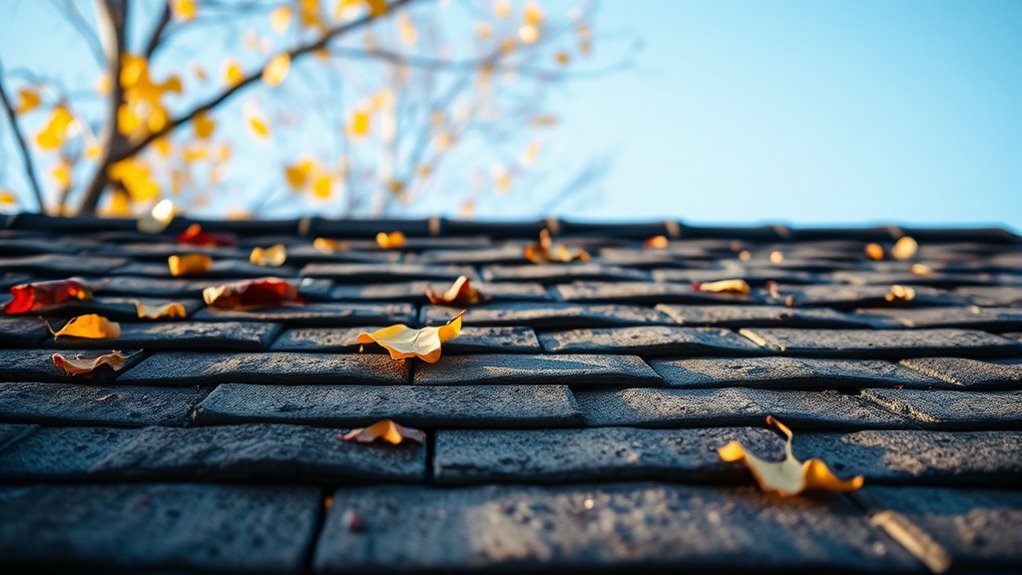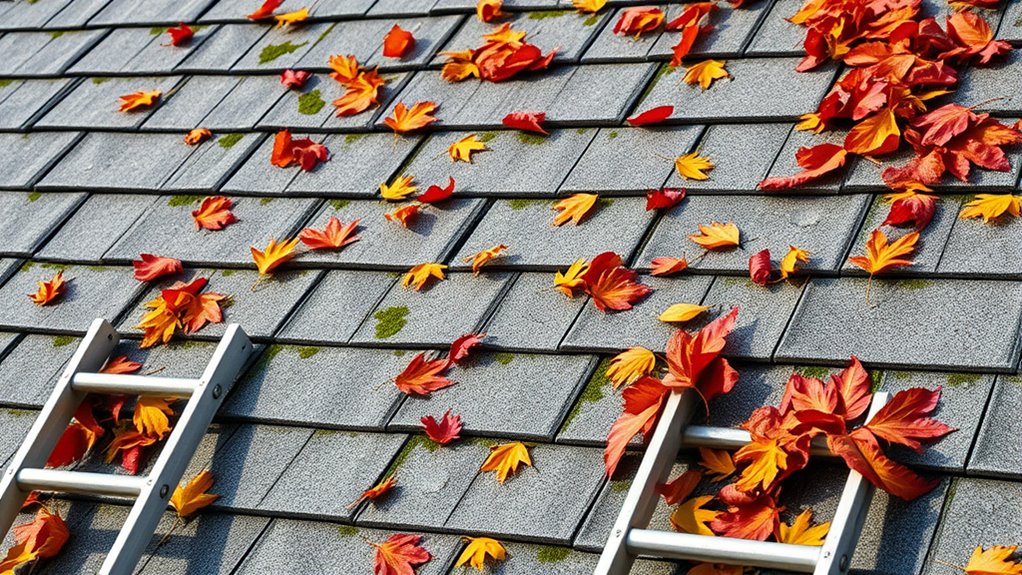To spot damage before leaks happen, perform seasonal roof checks by inspecting shingles for curling or missing pieces, examining flashing around chimneys and vents for cracks, and clearing gutters of debris to prevent water backup. Look inside for water stains on ceilings and walls that indicate leaks. Address any issues early to prevent costly repairs later. Continuing with this information will help you learn more about the key steps to keep your roof in top shape.
Key Takeaways
- Inspect shingles for missing, damaged, or curling edges to prevent water infiltration.
- Check flashing around chimneys, vents, and skylights for cracks or gaps.
- Clear gutters and downspouts of debris to ensure proper drainage and prevent water backup.
- Examine attic insulation and interior ceilings for water stains indicating hidden leaks.
- Schedule professional inspections after severe weather to identify less obvious roof damage.

Have you scheduled your seasonal roof check yet? If not, now’s the perfect time to get it done. Regular inspections are essential for catching minor issues before they turn into costly repairs. As the seasons change, your roof faces different challenges—extreme weather, falling debris, and temperature fluctuations—that can all cause damage or deterioration. A thorough inspection helps guarantee your roof remains in top condition and prevents leaks that could damage your home’s interior. Proper maintenance and understanding of roof components, such as flashing and insulation, are key to a long-lasting roof. Start by examining your roof’s surface. Look for missing or damaged shingles, curling edges, or signs of wear. These small problems can quickly escalate into leaks if left unattended. Don’t forget to inspect the flashing around chimneys, vents, and skylights, as these are common spots for water to seep in. While you’re at it, check your gutters and downspouts—gutter maintenance is crucial. Clogged or sagging gutters can cause water to back up and overflow, directing water toward your roof’s edges or foundation. Clearing debris and ensuring proper drainage can protect your roof’s integrity and prevent water from seeping into your home. Another key aspect often overlooked is roof insulation. Proper insulation helps regulate your home’s temperature, reducing strain on your heating and cooling systems. During your seasonal check, consider whether your attic or roof space needs additional insulation. Poor insulation can lead to ice dams in winter, which cause water to back up beneath shingles and leak inside. Adequate insulation also prevents heat from escaping in the winter, which can keep your roof cooler and reduce the risk of ice formation. While inspecting the roof surface and gutters, also look for signs of water damage or stains on interior ceilings and walls. These can be indicators of hidden leaks. If you notice any damp spots, it’s time to call in a professional for a closer look. Remember, safety comes first—if your roof is steep or high, it’s best to hire experts to perform the inspection. Checking for signs of wear and tear and understanding your roof’s features are crucial steps in maintaining its durability. Taking these steps during your seasonal roof check can save you money and stress in the long run. By addressing minor issues early—like fixing damaged shingles, cleaning gutters, or upgrading roof insulation—you prevent small problems from becoming major repairs. Regular maintenance keeps your roof durable and your home protected, no matter what the season throws at you. Don’t wait until leaks appear; be proactive and keep your roof in excellent shape year-round.
Frequently Asked Questions
How Often Should I Schedule a Roof Inspection?
You should schedule a roof inspection at least twice a year, especially during spring and fall. Regular roof maintenance helps you catch damage early, preventing leaks and costly repairs. Use an inspection checklist to identify issues like missing shingles, cracks, or moss buildup. By staying proactive, you protect your home and extend your roof’s lifespan. Don’t wait until problems become visible—annual checks are essential for a durable, leak-free roof.
What Tools Are Needed for a DIY Roof Check?
Think of yourself as a roof detective. To perform a DIY roof check, grab roofing gloves to protect your hands and an inspection mirror to see hard-to-reach spots. You might also need a sturdy ladder, a flashlight, and binoculars for a thorough look. These tools help you spot damage early, preventing costly leaks later. Always prioritize safety and take your time for the best results.
Can Roof Damage Affect Indoor Air Quality?
Roof damage can definitely affect your indoor air quality. When your roof is compromised, it can lead to leaks that allow moisture to seep in, impacting your HVAC system’s efficiency. This moisture promotes mold growth, which releases spores into your indoor air, causing health issues. Regular roof inspections help catch damage early, preventing mold and maintaining better air quality inside your home.
How Long Does a Professional Roof Inspection Take?
A professional roof inspection usually takes about 1 to 3 hours, depending on your roof’s size and complexity. During the inspection, the inspector focuses on roof safety and follows a detailed checklist to identify potential issues. You can prepare by clearing debris and ensuring access points are free. This thorough process helps catch problems early, preventing costly repairs and ensuring your roof remains in top condition.
What Are Signs of Hidden Roof Damage?
Ever wondered how you can tell if your roof has hidden damage? Look out for signs like shingle deterioration, which weakens your roof’s protection, and moss growth, indicating persistent moisture issues. These problems often hide beneath the surface, but catching them early can prevent leaks. Regular inspections help you spot these signs before they cause costly damage, ensuring your roof stays strong and leak-free.
Conclusion
By conducting a seasonal roof check, you’re fundamentally donning a vigilant armor against nature’s unpredictable temper. Spotting damage early is like catching a whisper before it becomes a thunderclap—saving you from costly leaks and repairs. Think of your roof as a silent guardian, quietly shielding your home. When you stay proactive, you’re weaving a sturdy shield that withstands the storms, ensuring your sanctuary remains safe and dry through every season’s dance.








